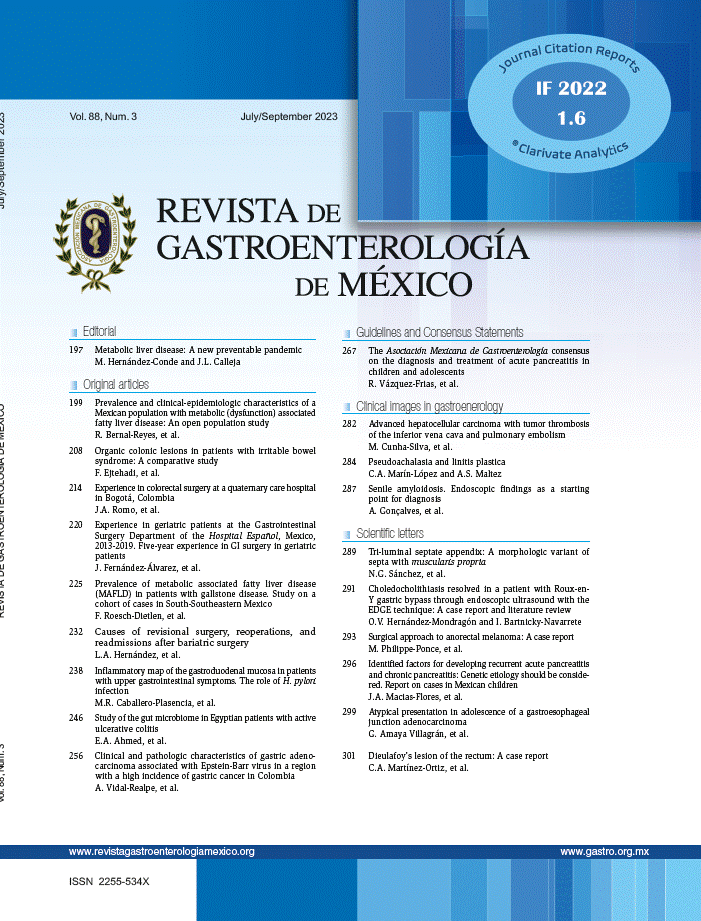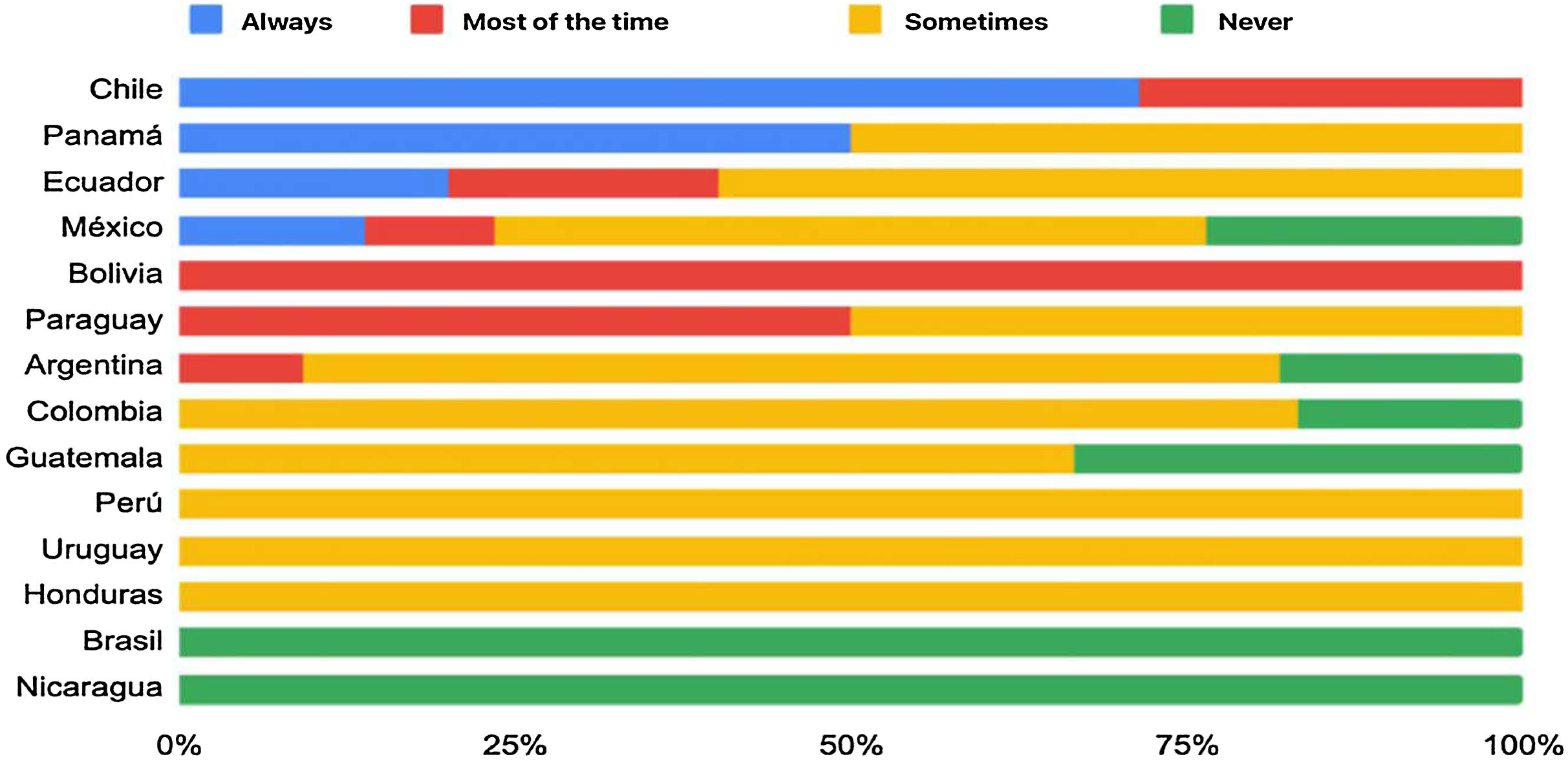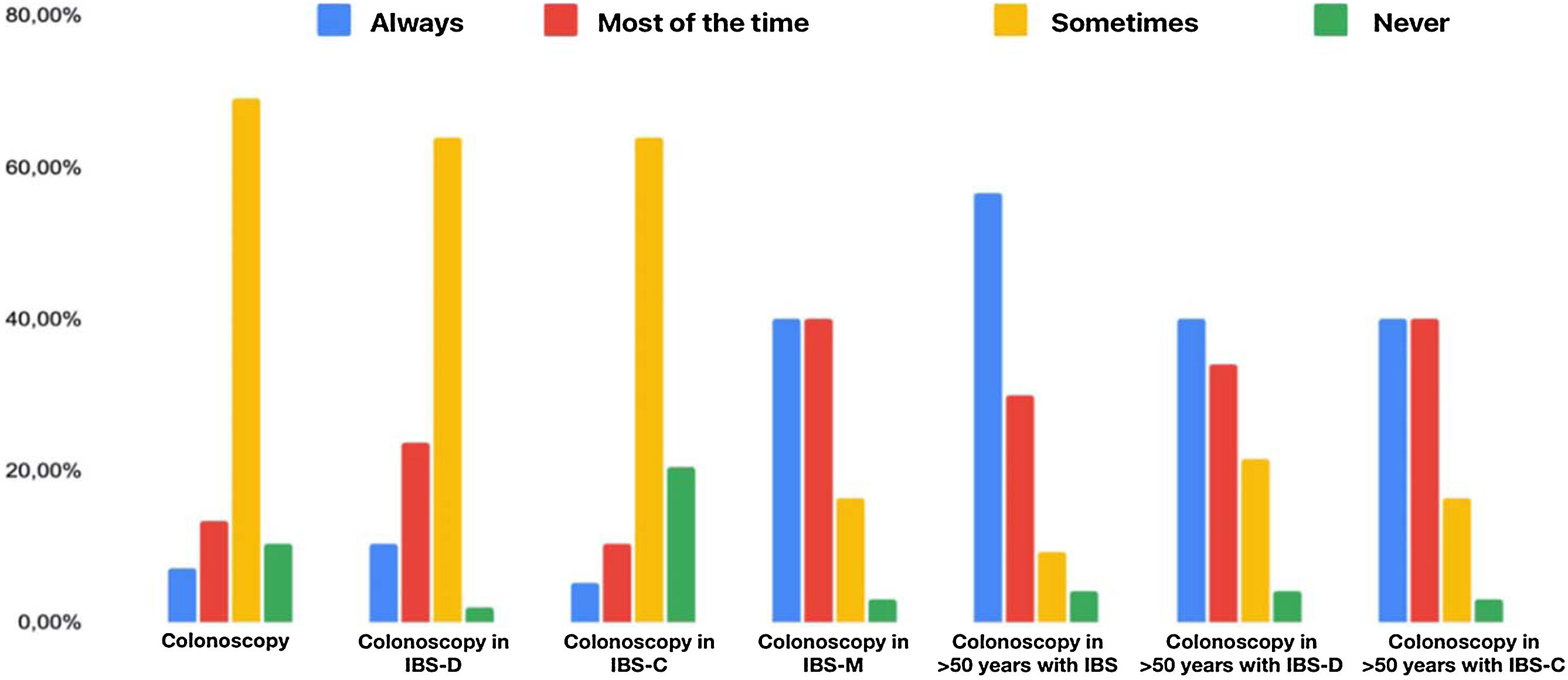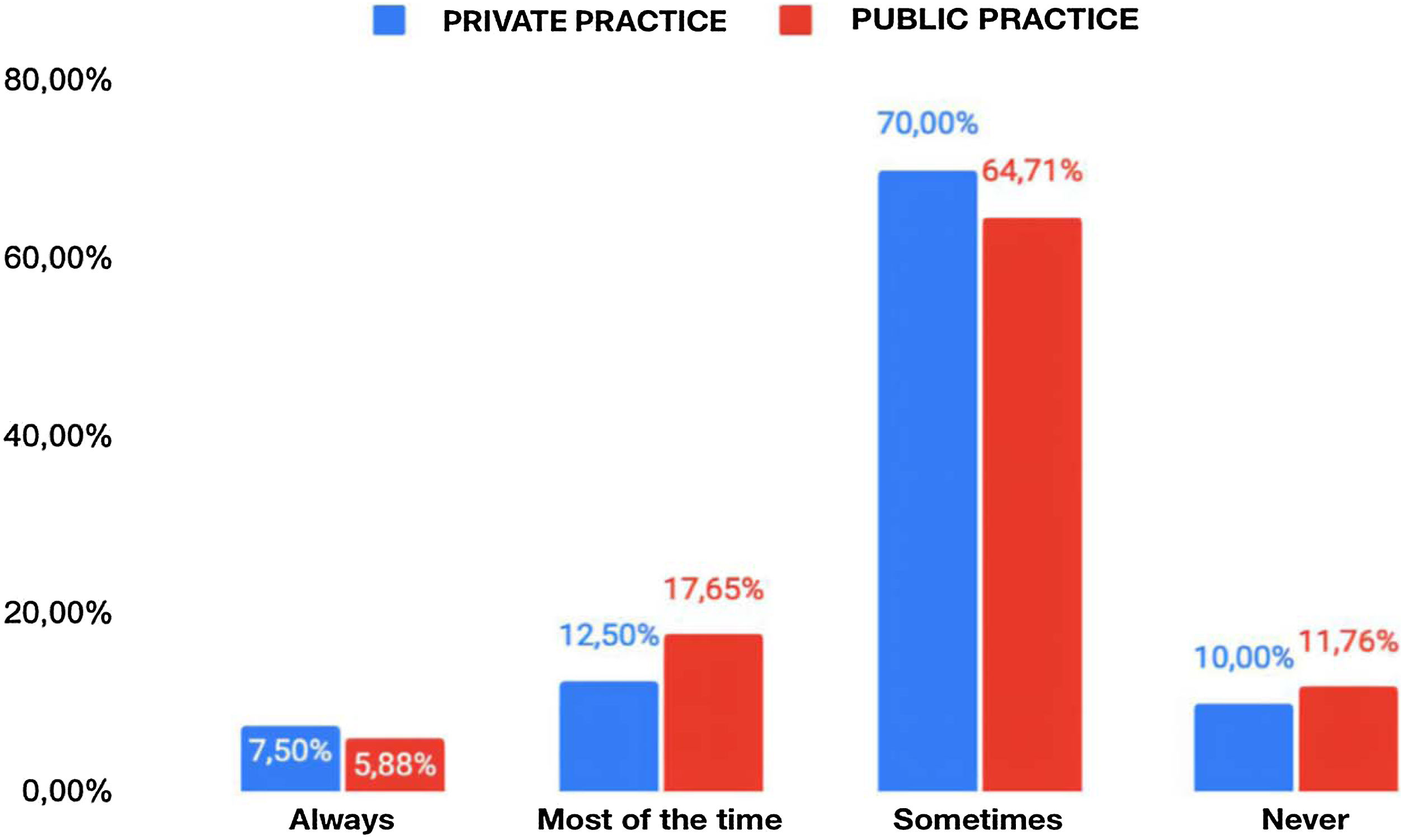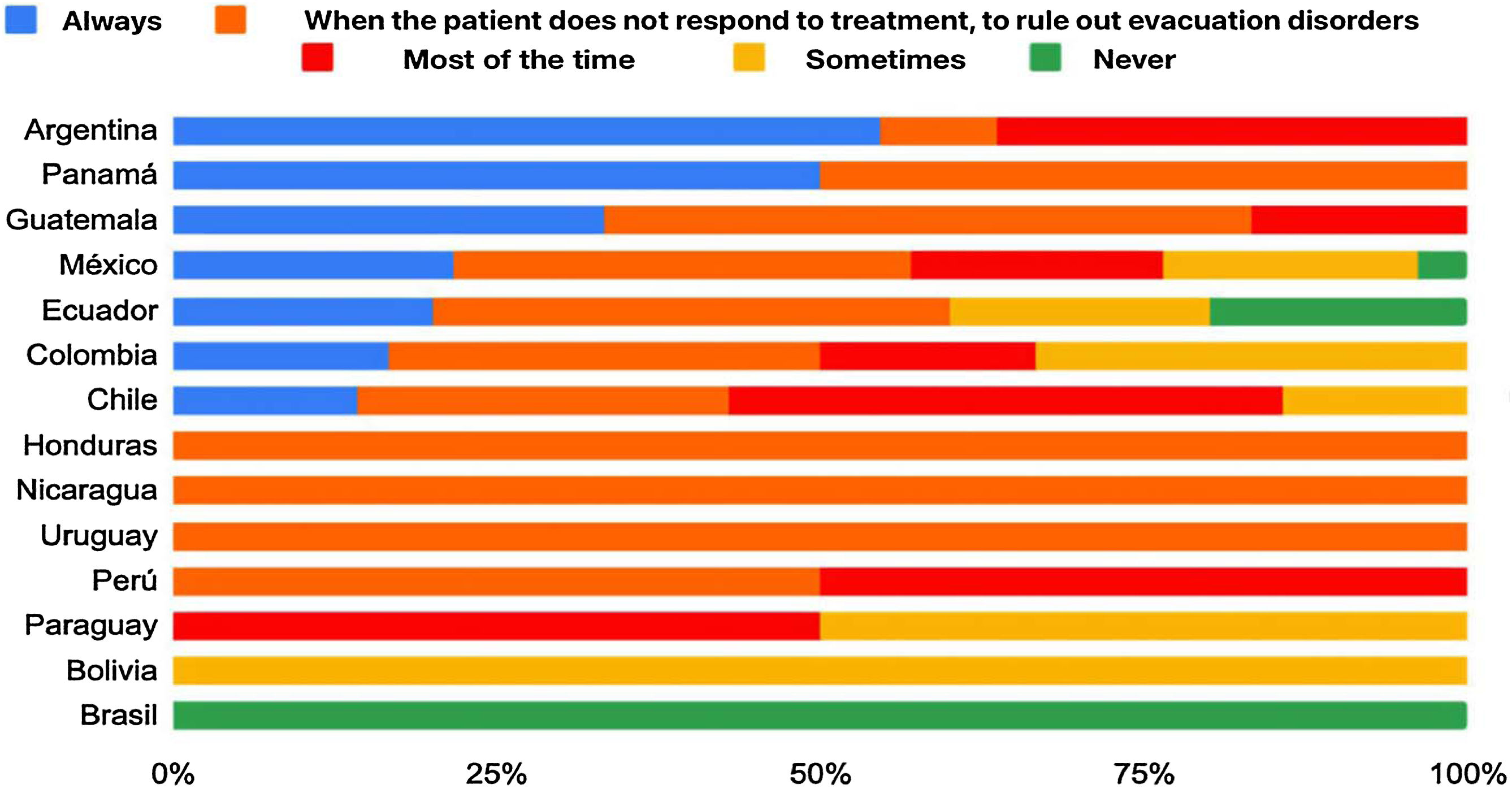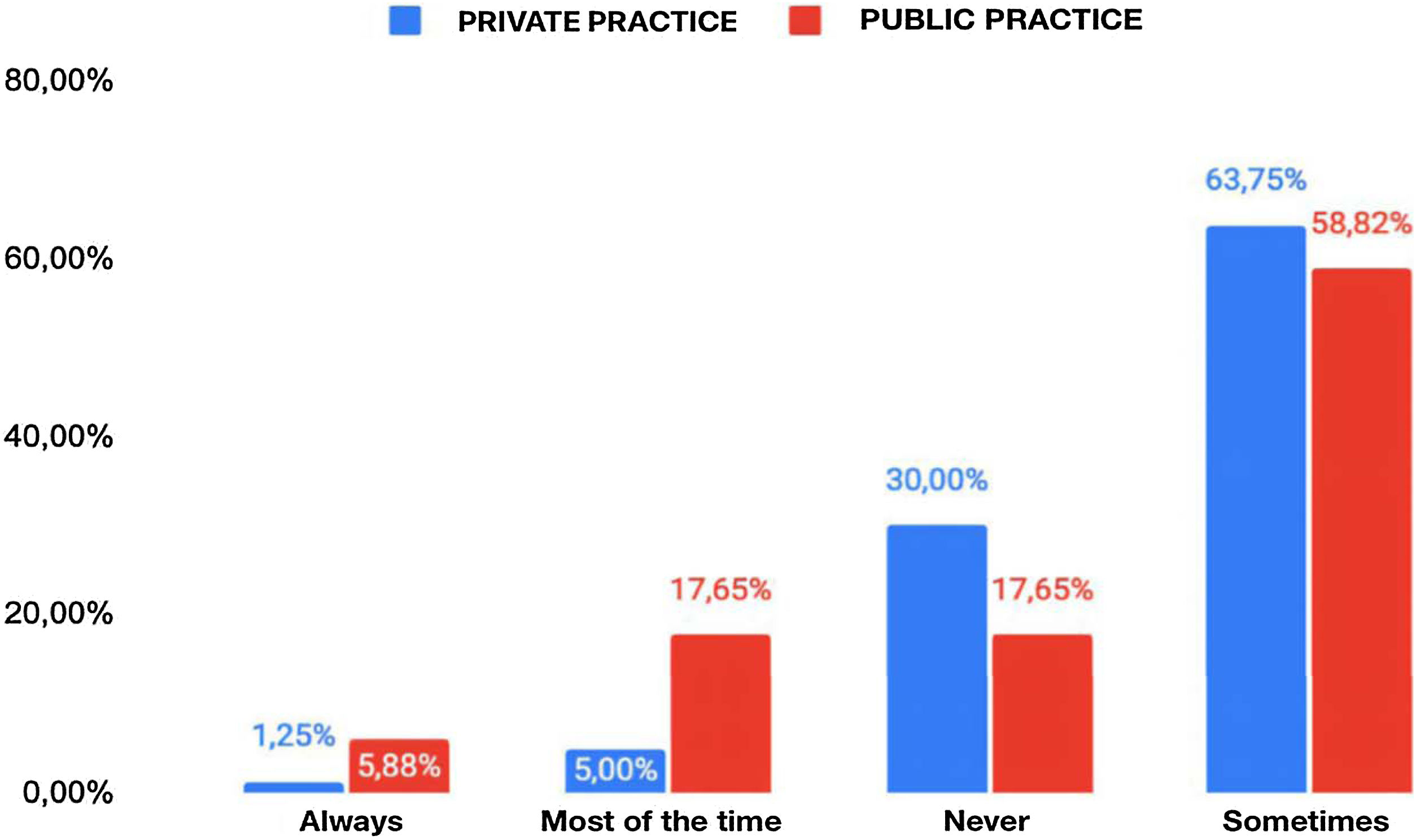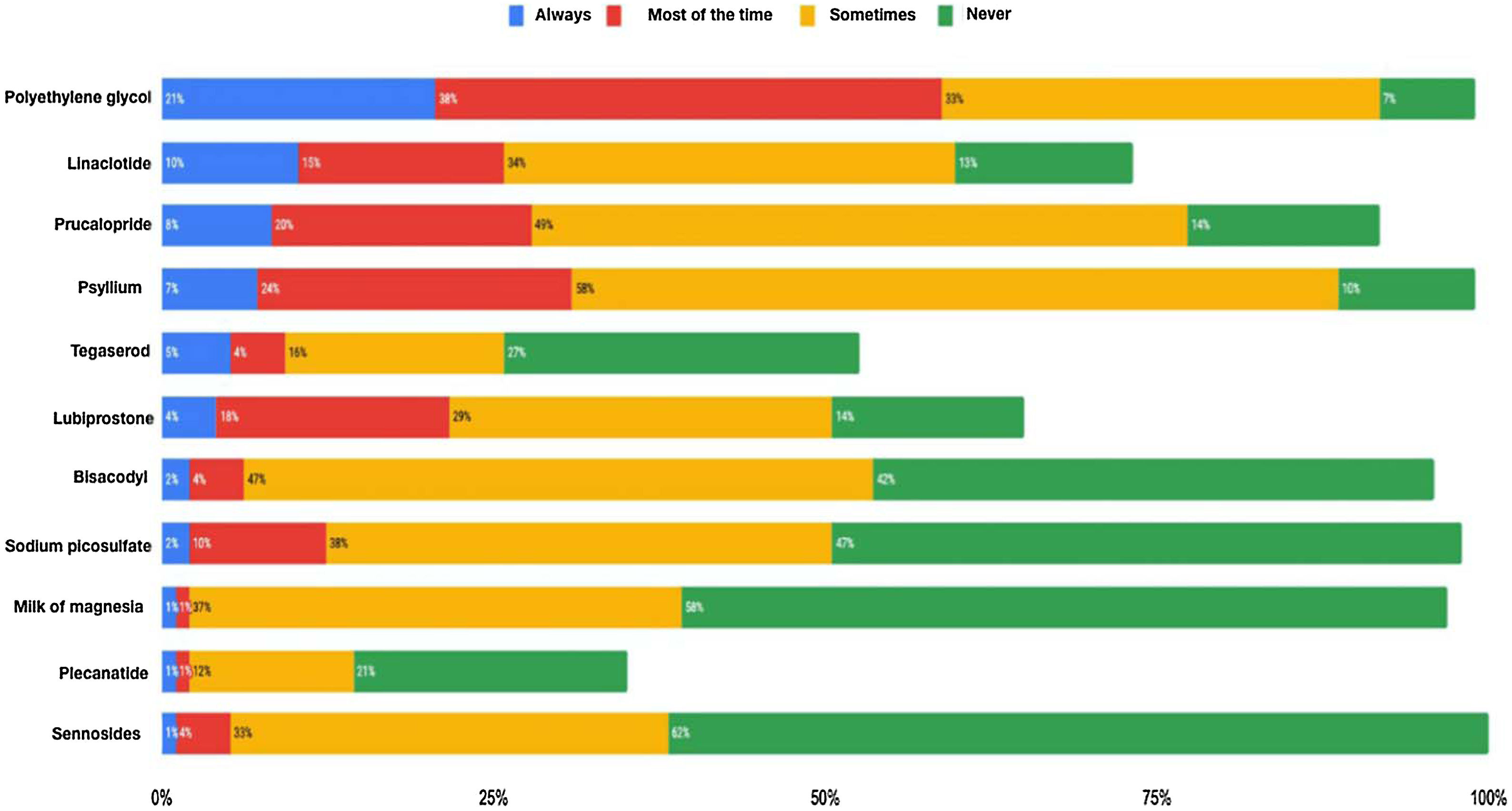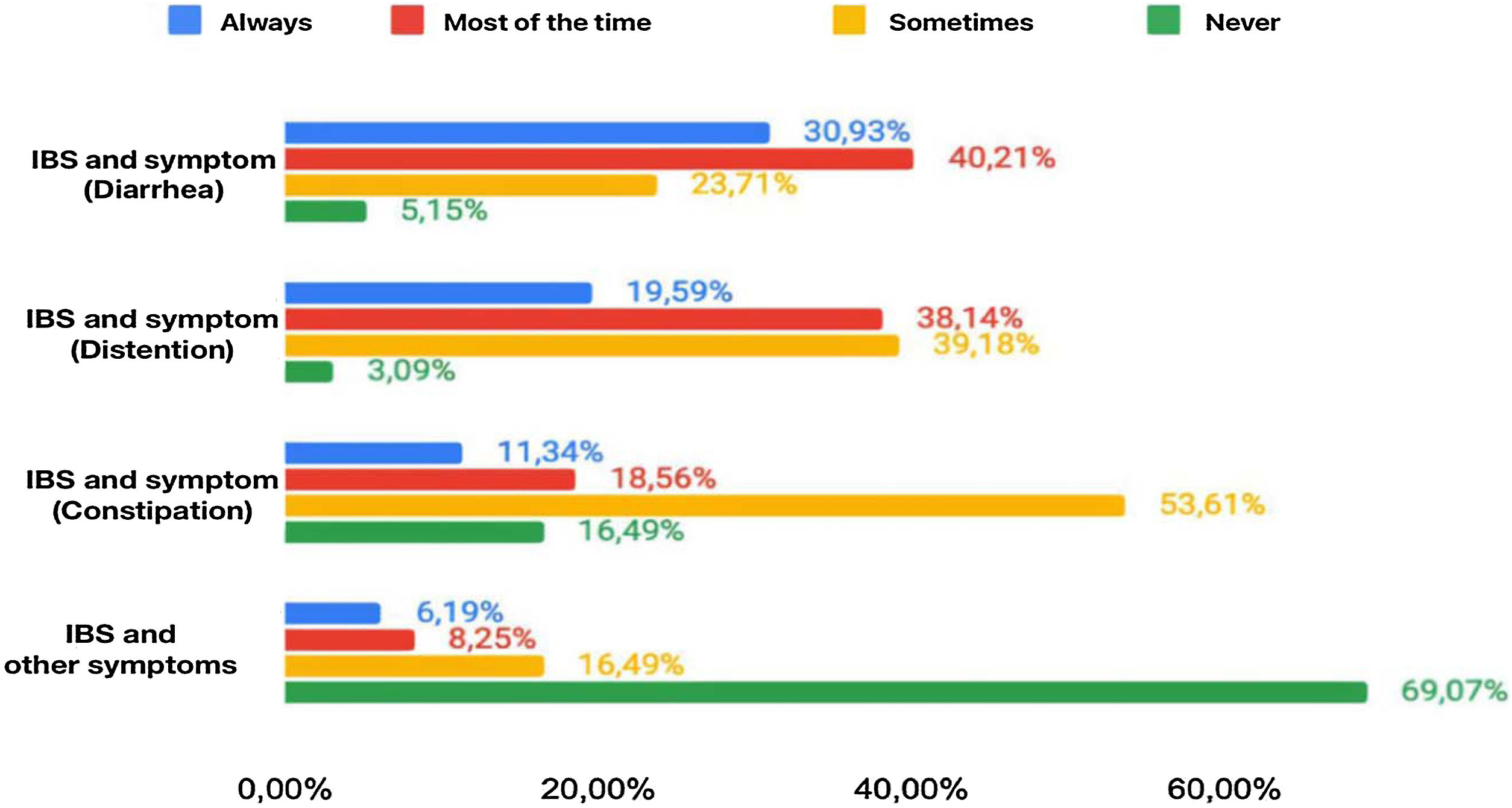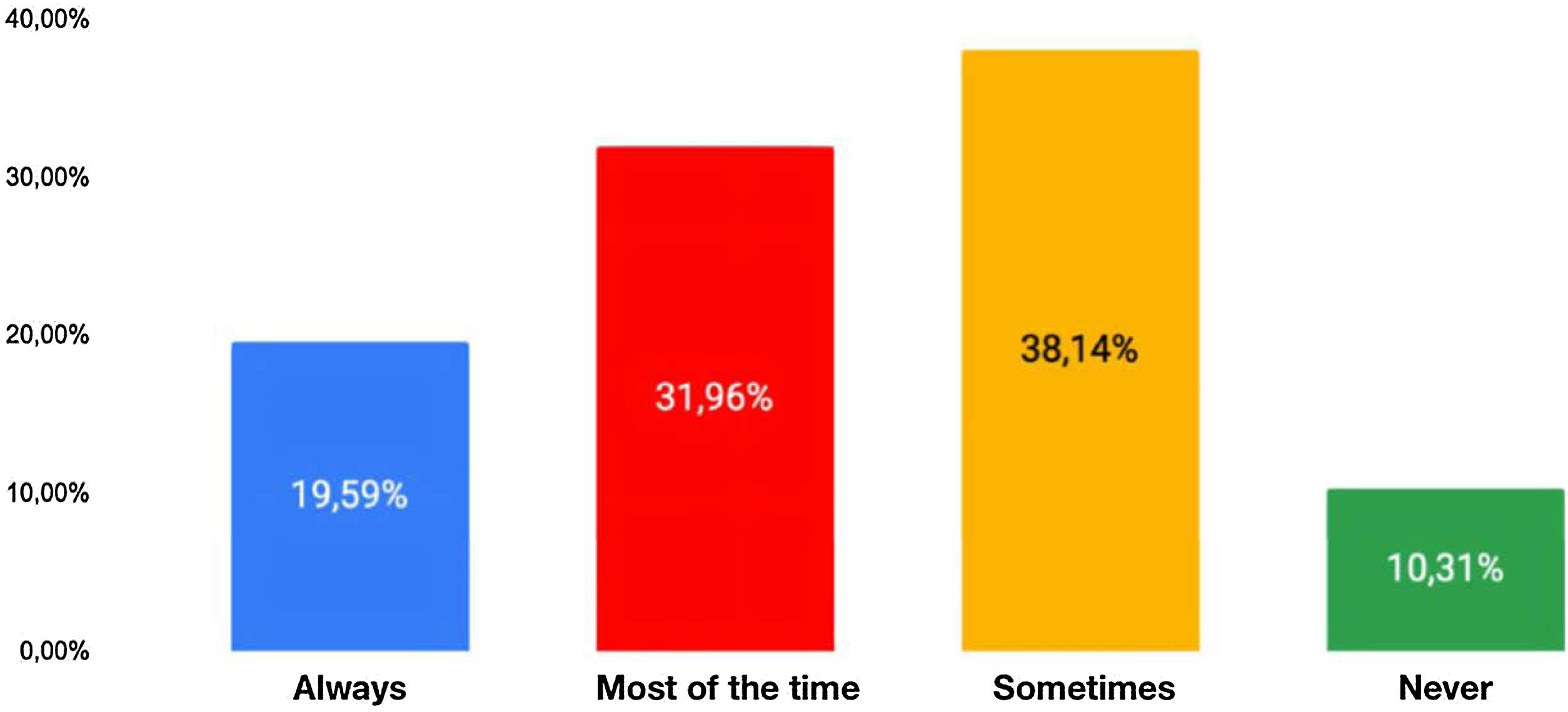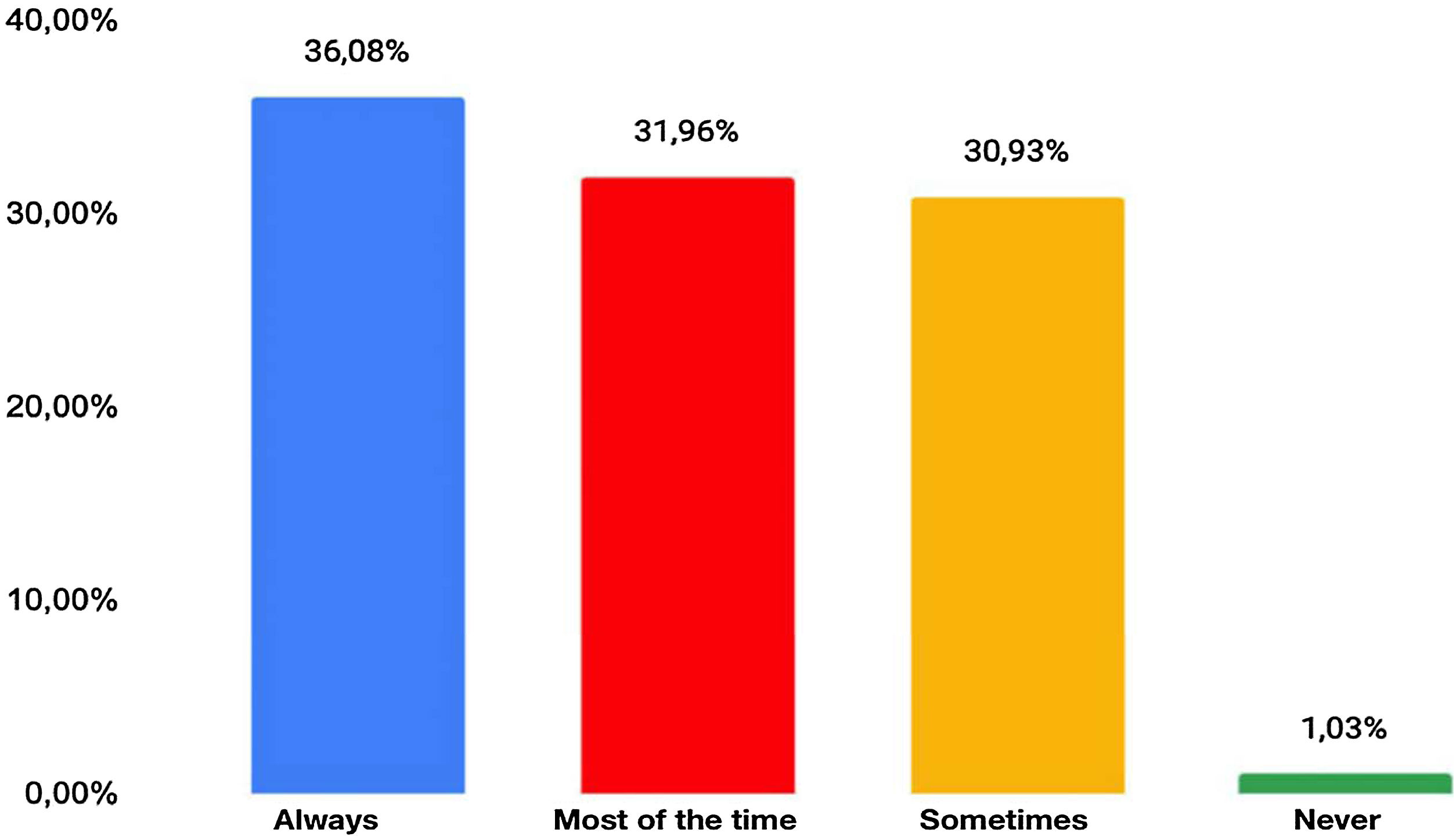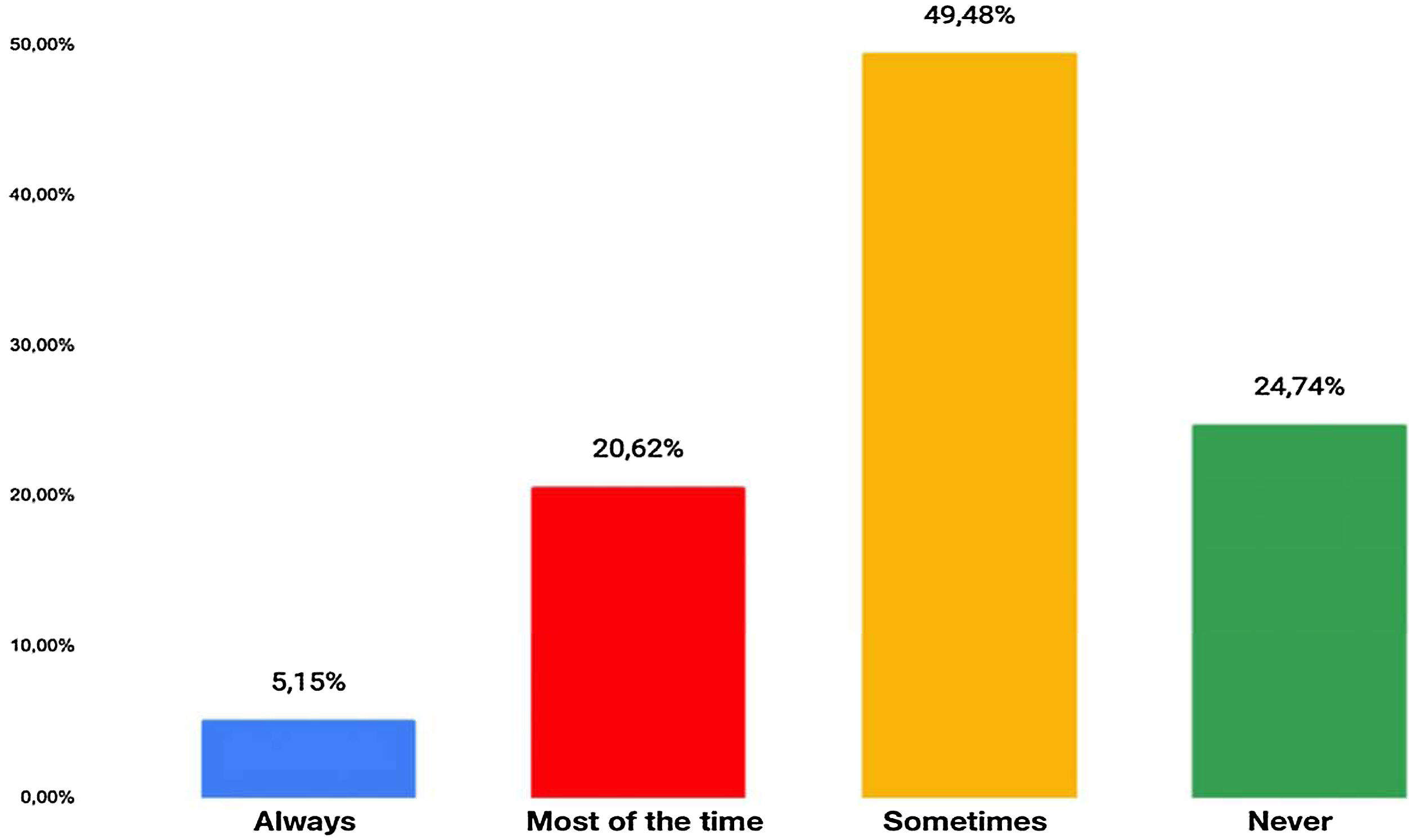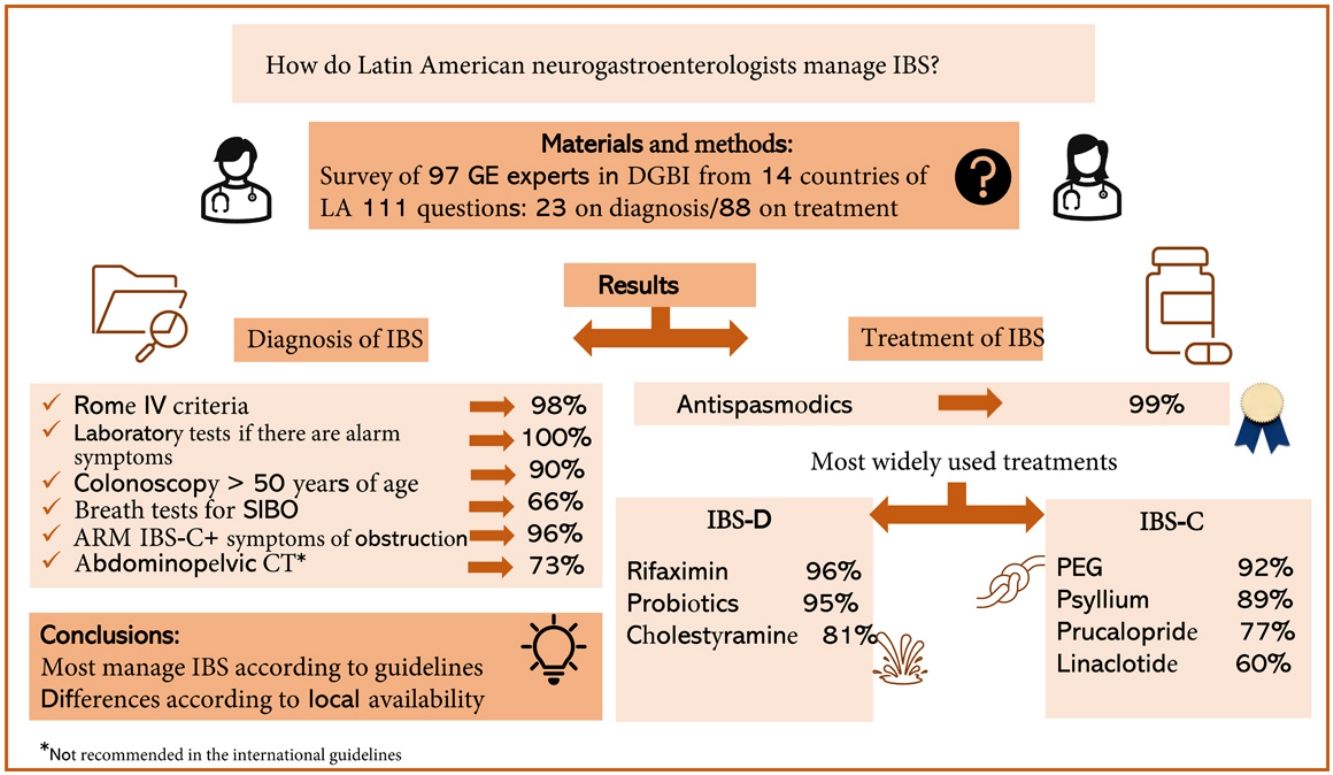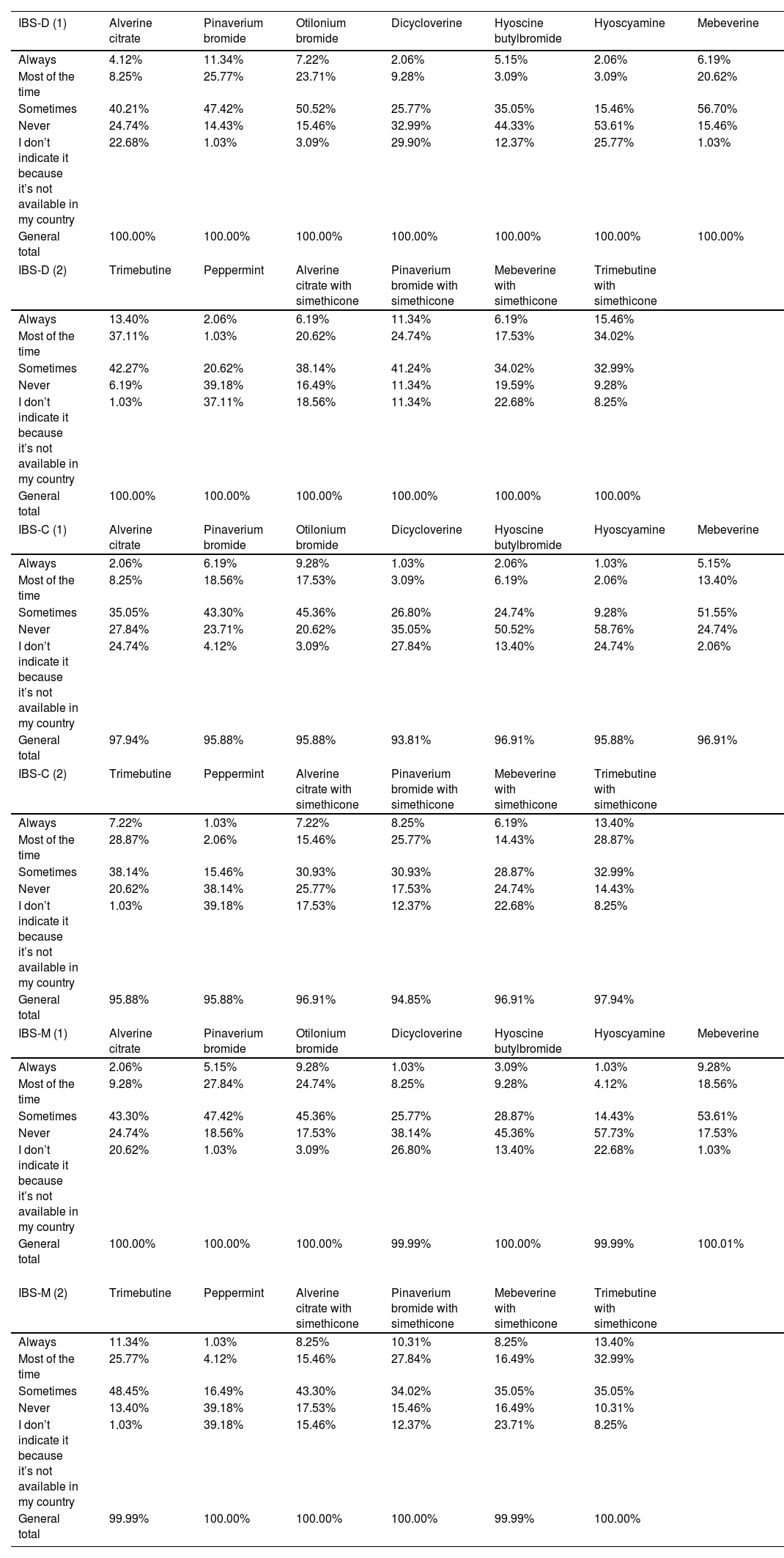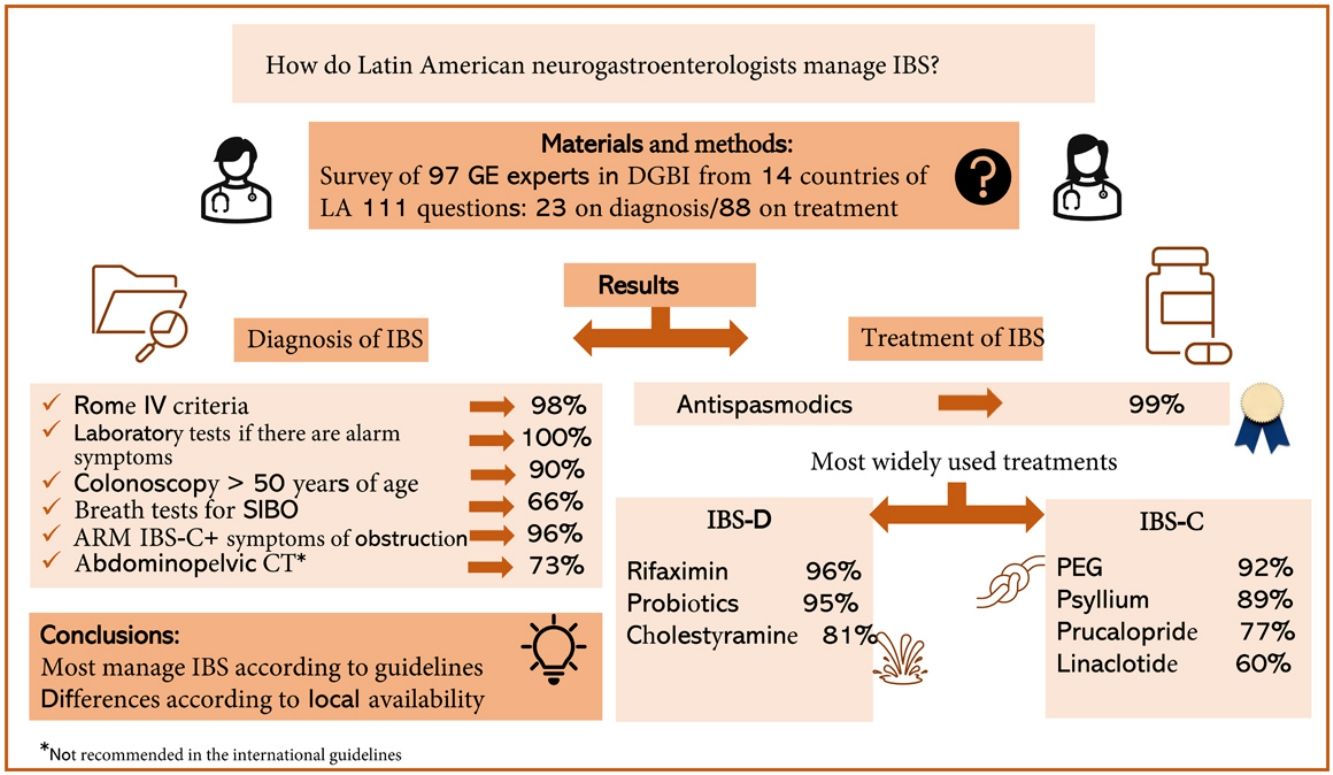Even though the guidelines on irritable bowel syndrome (IBS) are similar worldwide, there are differences between countries that can influence management. Our aim was to evaluate the heterogeneity in IBS management in Latin America.
Materials and methodsAn internet survey was applied to 97 gastroenterologists, specialists in disorders of gut-brain interaction (DGBI), from 14 Latin American countries, and included 111 questions: 23 on diagnosis and 88 on treatment. An exploratory, descriptive, observational analysis was carried out on general qualitative data, by IBS subtype and by country.
ResultsDiagnostic data: 98% of those surveyed utilize the Rome IV criteria; 100% order laboratory tests when there are alarm symptoms; 90% order colonoscopy in patients over 50 years of age; 73% order abdominopelvic CT; 66% order breath tests for SIBO; and 96% order anorectal manometry in IBS-C with symptoms of a defecation disorder. Treatment data: antispasmodics are the most widely prescribed drugs, with differences according to IBS subtype and local availability; 83% indicate a low FODMAP diet; in IBS-D and abdominal distension, more than 90% prescribe rifaximin and/or probiotics, and 81%, cholestyramine; in IBS-C, the most widely prescribed treatments are polyethylene glycol, psyllium, prucalopride, and linaclotide; up to 94% indicate neuromodulators as second-line treatment; and 99% consider indicating psychotherapy in cases of depression.
ConclusionsEven though most of the specialists diagnose and treat IBS in accordance with guidelines, there are differences regarding local availability, and abdominopelvic CT appears to be overused. Knowing how general practitioners and internists manage this entity would be useful for establishing practical guidelines on the diagnosis and treatment of IBS that are adjusted by country.
Aunque las guías de síndrome de intestino irritable (SII) son similares globalmente, existen diferencias entre países que pueden influir en el manejo.
ObjetivoEvaluar la heterogeneidad en el manejo del SII en Latinoamérica.
Materiales y métodosEncuesta por internet a 97 gastroenterólogos expertos en trastornos de interacción intestino cerebro (TIIC) de 14 países, incluyendo 111 preguntas: 23 de diagnóstico y 88 de tratamiento. Análisis observacional descriptivo de exploración de datos de variables cualitativas generales, según subtipo de SII, y por países.
ResultadosDiagnóstico; 98% usa criterios de Roma IV. Todos solicitan pruebas de laboratorio ante signos de alarma y 90% solicita colonoscopia en mayores de 50 años. 73% ordena TAC abdominopélvica, 66% pruebas de aliento para SIBO, y 96% manometría anorrectal en SII-E con síntomas de trastorno evacuatorio. Tratamiento; los antiespasmódicos son los más recetados con diferencias de acuerdo con subtipo y disponibilidad local. En cuanto a dieta, 83% indica dieta baja en FODMAPs. En SII-D y distensión abdominal, más de 90% utiliza rifaximina y/o probióticos, y 81% colestiramina. En SII-E los tratamientos más recetados son polietilenglicol, psyllium, prucaloprida y linaclotida. Hasta 94% indica neuromoduladores como tratamiento de segunda línea, y 99% considera psicoterapia ante depresión.
ConclusionesAunque la mayoría de los expertos diagnostica y trata el SII conforme a guías, existen diferencias de acuerdo con la disponibilidad local y parece abusarse de estudios como TAC abdominopélvica. Sería útil conocer el manejo de médicos generales e internistas y establecer guías prácticas para diagnóstico y tratamiento ajustadas por países.
Irritable bowel syndrome (IBS) is a disorder of gut-brain interaction (DGBI), characterized by the presence of abdominal pain and altered bowel movements, and is classified based on the predominant bowel habit as diarrhea-predominant IBS (IBS-D), constipation-dominant IBS (IBS-C), mixed IBS (IBS-M), and unclassifiable IBS (IBS-U).1 In the global epidemiology study conducted by the Rome Foundation, the reported prevalence of IBS, according to the Rome IV criteria, was 4.1% in the four Latin American countries that were included (Argentina, Colombia, Brazil, and Mexico).2
In general, clinical practice guidelines on IBS are similar internationally.3–8 For example, the recent guidelines from the American College of Gastroenterology (ACG) suggest a positive diagnosis of IBS, as opposed to a rule-out diagnosis. They recommended performing serologic tests to rule out celiac disease in patients with IBS and symptoms of diarrhea, as well as the calprotectin stool test in patients with those symptoms, to rule out inflammatory bowel disease. Regarding treatment, they suggested utilizing a limited cycle of a low FODMAP diet for improving overall IBS symptoms. Rifaximin was also recommended for treating overall symptoms of IBS-D, as well as gut-targeted psychotherapy for treating overall IBS symptoms. Interestingly, those guidelines did not recommend using antispasmodics available in the United States due to a low quality of evidence on the topic.3 In contrast, the guidelines from the American Gastroenterological Association (AGA) focused on IBS management and divided their recommendations between those for IBS-D5 and IBS-C.6 For IBS-D, the panel established conditional recommendations for eluxadoline, rifaximin, alosetron, (moderate certainty), loperamide (very low certainty), and antispasmodics and tricyclic antidepressants (low certainty), as well as for selective serotonin reuptake inhibitors (SSRIs) (low certainty).5 For IBS-C, the panel strongly recommended linaclotide (high certainty) and established conditional recommendations in favor of tenapanor, plecanatide, tegaserod, and lubiprostone (moderate certainty), polyethylene glycol, tricyclic antidepressants, and antispasmodics (low certainty). They also made a conditional recommendation against the use of SSRIs (low certainty).6 It should be noted that due to insufficient evidence, the guidelines, in general, make no recommendations on the treatment of IBS-M.
In Latin America, the latest consensus on IBS from the Asociación Mexicana de Gastroenterología (AMG) stated there was insufficient evidence for recommending the performance of a standardized group of diagnostic tests in all patients meeting the criteria based on symptoms for IBS, and that the selection of diagnostic tests should be done individually, considering the clinical characteristics of IBS and the pre-test probability of an organic disease (e.g., celiac disease [CD], inflammatory bowel disease, neoplasms, etc.). Colonoscopy should be performed in IBS patients with risk factors for colon cancer, symptom onset at late stages in life, changes in habitual bowel pattern, presence of blood in stools, and in patients who are nonresponders to treatment. In patients with refractory IBS-D, the consensus panel recommended taking biopsy samples from the colon, even in the absence of lesions, to intentionally look for microscopic colitis. Likewise, they also agreed there was insufficient evidence for recommending the routine use of tests for detecting bacterial overgrowth in all patients with IBS. Regarding treatment, the panel made recommendations on exercise and the low FODMAP diet. Antispasmodics were recommended for their greater efficacy, compared with placebo, in improving abdominal pain, overall improvement, and in improving IBS symptom scores. The combination of antispasmodics and simethicone/dimethicone was also recommended for its effect on improving pain and bloating. In IBS-C, polyethylene glycol and linaclotide were recommended for improving stool frequency and consistency, with the latter agent also improving bloating and abdominal discomfort. Regarding antidepressants, in general, including tricyclic antidepressants and SSRIs, the panel determined they were shown to be effective in overall improvement of IBS symptoms. Rifaximin was recommended because of its effect on overall symptom improvement of IBS with no constipation. There was not enough evidence for recommending the use of prebiotics and synbiotics in IBS, in general.7 It should be noted that the AMG just published a document on the treatment of IBS based on treatments that are available in Mexico.8
In addition to the variations there may be between the different guidelines and consensuses, there are also differences that can influence the diagnostic and treatment strategies for IBS, based on access to diagnostic tests and the availability of medications at the local level. Lastly, there is also variability due to healthcare system regulations and experience in IBS management. Thus, the aim of this study was to evaluate the heterogeneity in the diagnostic study of and choice of treatment for IBS, between Latin American gastroenterologists who are specialists in DGBI.
Materials and methodsA cross-sectional survey was carried out via the internet, applying it to 97 gastroenterologists, specialists in neurogastroenterology, from 14 Latin American countries: Argentina, Bolivia, Brazil, Colombia, Chile, Ecuador, Guatemala, Honduras, Mexico, Nicaragua, Panama, Paraguay, Peru, and Uruguay. The experts were invited to participate in the survey, based on their training in neurogastroenterology and their membership in the Sociedad Latinoamericana de Neurogastroenterología (SLNG) and other local societies of the specialty. The STROBE checklist suggested for cross-sectional studies was utilized.
Statistical analysisThe survey included 111 questions, 23 of which were related to the diagnosis of IBS, and 88 on its treatment (Supplementary material 1). The Microsoft Excel® program was utilized for making the calculations, organizing the data, and creating the tables and graphs. For statistical significance, the Fisher’s exact test was used to calculate the p value for a 2 × 2 frequency table. The questionnaire items included questions on the diagnostic criteria utilized, i.e., the Manning, Rome I, Rome II, Rome III, or Rome IV criteria, or if the diagnosis was based on personal experience. The items also asked about the indications for clinical laboratory tests (hemogram, thyroid hormones, CD serologic test, fecal occult blood test, and/or calprotectin stool test) in patients according to IBS subtype, as well as the indications for colonoscopy, abdominopelvic computed tomography (CT), anorectal manometry and/or breath tests for diagnosing small intestinal bacterial overgrowth (SIBO), glucose malabsorption, or fructose malabsorption. Regarding treatment, the questionnaire items asked how frequently dietary treatments (including diets low in fermentable oligosaccharides, disaccharides, monosaccharides, and polyols [FODMAPs], low in gluten, and low in dairy products) were indicated and how often medical treatments with antispasmodics, neuromodulators, probiotics, rifaximin, antidiarrheics, and laxatives, as well as psychotherapy and alternative therapies, were recommended. An exploratory, descriptive, observational analysis was carried out on general qualitative data.
ResultsParticipating expertsFig. 1 shows the 14 countries the DGBI specialists participating in the survey came from. Over half of them were from Mexico, followed by 11.3% from Argentina, and 7.2% from Chile. A total of 82.5% of the specialists worked in private practices and 17.5% in public healthcare systems.
Diagnosis of irritable bowel syndromeDiagnostic clinical criteriaNinety-nine percent of the physicians surveyed reported using diagnostic criteria for IBS (Manning, Rome I, Rome II, Rome III, or Rome IV criteria) with greater or lesser degrees of frequency; only one participant reported never using said criteria, exclusively utilizing personal experience for making the diagnosis. The Rome IV criteria were the most widely used, with 95% of the participants employing them “always” or “most of the time” and 3% “sometimes”. Concerning the other diagnostic criteria, 47% never utilized the Rome I, II, or III criteria, 75% never used the Manning criteria, and 72% stated they never based their diagnosis of IBS exclusively on their experience.
Clinical laboratory testsWith varying frequency, and regardless of IBS subtype, 97% of the experts stated they ordered a hemogram, 95% a CD serologic test, 90% a thyroid test, 85% a fecal occult blood test, and 80% a calprotectin stool test. Likewise, in the presence of alarm symptoms, 100% of those surveyed stated they ordered tests in addition to the clinical diagnosis (hemogram, CD serologic test, thyroid test, fecal occult blood test, calprotectin stool test), which was the only unanimous result between the participants. In the analysis by country, a CD serologic test stood out as “always” ordered by 91% of the participants from Argentina, and 86% from Chile; a calprotectin stool test was “always” ordered by 71% of the participants from Chile, contrasting with the 14% from Mexico who “always” ordered a calprotectin stool test and the 12% who “always” ordered a CD serologic test, in patients with IBS (Figs. 2 and 3) (Table 1).
Clinical laboratory test ordering in patients with IBS.
| Ordering frequency in IBS | Hemogram | Thyroid test | Celiac disease serologic test | Calprotectin stool test | Fecal occult blood test |
|---|---|---|---|---|---|
| Always | 52.58% | 31.96% | 25.77% | 14.43% | 31.96% |
| Most of the time | 16.49% | 25.77% | 14.43% | 11.34% | 18.56% |
| Sometimes | 27.84% | 32.99% | 54.64% | 54.64% | 35.05% |
| Never | 3.09% | 9.28% | 5.15% | 19.59% | 14.43% |
| General total | 100.00% | 100.00% | 100.00% | 100.00% | 100.00% |
IBS: irritable bowel syndrome.
Table 2 provides a detailed description of the frequency with which the specialists ordered imaging studies in patients with IBS. The results, according to each of the tests, follow below.
Imaging study ordering in patients with IBS.
| Ordering frequency in IBS | Colonoscopy | Abdominopelvic CT | Anorectal manometry (IBS-C) | Anorectal manometry (IBS-C with defecation disorder) | Breath test (SIBO) |
|---|---|---|---|---|---|
| Always | 7.22% | 2.06% | 2.06% | 23.71% | 2.00% |
| Most of the time | 13.40% | 8.25% | 7.22% | 21.65% | 17.3% |
| Sometimes | 69.07% | 62.89% | 62.89% | 16.49% | 46.00% |
| Never | 10.31% | 26.80% | 27.84% | 4.16% | 33.7% |
| General total | 100.00% | 100.00% | 100.00% | 100.00% | 100.00% |
CT: computed tomography; IBS: irritable bowel syndrome; IBS-C: constipation-predominant irritable bowel syndrome; SIBO: small intestinal bacterial overgrowth.
Colonoscopy: With differences in frequency, 90% of the Latin American specialists stated they ordered colonoscopy in patients with IBS, although most of the participants (69%) only indicated it “sometimes”. Ninety-five percent of the experts responded that they ordered a colonoscopy in patients above 50 years of age, with 80% “sometimes” or “most of the time” ordering it in that age group. According to IBS subtype, 98% indicated colonoscopy in IBS-D, but the majority (64%) only “sometimes”, and 97% indicated colonoscopy in IBS-M, with the majority (80%) “always” or “most of the time”. There were no differences between participants working in the public healthcare system or in private practice (Figs. 4 and 5).
Abdominopelvic CT: A total of 73.2% responded that they ordered a CT study “always”, “most of the time” or “sometimes”, with most (63%) stating only “sometimes”. There were also no differences between those working in the public healthcare system or in private practice.
Anorectal manometry: Seventy-two percent of the experts stated they performed anorectal manometry in patients with IBS-C, regardless of their clinical characteristics; the percentage reached 96% in patients with IBS-C and symptoms suggestive of a defecatory disorder. However, anorectal manometry was ordered immediately (“always”, “most of the time”, “sometimes”) in 61.8% of the participants, whereas 34.2% stated they ordered it only after a poor response to medical treatment in those patients (Fig. 6). This varied, depending on the type of practice of the specialists; those working in the public healthcare system ordered anorectal manometry in IBS-C and signs of obstructive constipation more frequently than the experts in private practice. In contrast, 30% of those in private practice “never” ordered the study, compared with 17.6% of the specialists in the public healthcare system, but the difference was not statistically significant (p = 0.23) (Fig. 7).
Breath tests: Sixty-six percent of the experts surveyed stated they ordered breath tests for diagnosing SIBO but the percentage that ordered them “always” or “almost always” was only 20%. That percentage was higher, at 65%, for the specialists from Argentina, who also indicated it more frequently, followed by the experts from Chile, at 42%. Indications for breath tests for diagnosing lactose and fructose malabsorption were 64 and 51%, respectively, with different levels of frequency.
Treatment of irritable bowel syndromeDietary modificationsEighty-three percent of the participants stated they recommended low FODMAP diets; 12% “always”, 37% “most of the time”, and 33% only “sometimes”. Frequency rose to 93% when there were cases of abdominal distension, and in those patients, 46% of the experts indicated the diet “always” or “almost always”, and 46% only “sometimes”. On the other hand, 82% of the specialists recommended other diets, such as those low in gluten or low in dairy products, with 53% recommending them “most of the time”.
Pharmacologic treatmentPharmacologic treatment was analyzed based on the levels of complexity of the different options, encompassing antispasmodics, management of constipation and diarrhea, probiotics, rifaximin, and neuromodulators, and are described below.
Antispasmodics: These medications were reported as the most widely used for IBS by the Latin American experts, given that 99% stated they considered at least one antispasmodic for treating IBS. However, there were differences according to IBS subtype: in IBS-D, 93% considered trimebutine, 85% pinaverium bromide, and 84% mebeverine; in IBS-M, 86% indicated trimebutine, 81% mebeverine or trimebutine + simethicone, and 80% pinaverium bromide; and in IBS-C, 75% used trimebutine, 74% trimebutine + simethicone, and 72% otilonium bromide. With respect to the least utilized antispasmodics, 40% did not prescribe peppermint, 30% did not prescribe dicycloverine, and 25% did not prescribe hyoscyamine or alverine citrate, given that none of those medications were available in the corresponding countries (Table 3).
Indication for antispasmodics, according to IBS subtype. A1-A2: IBS-D; B1-B2: IBS-C; C1-C2: IBS-M; A1. A2. B1. B2. C1. C2.
| IBS-D (1) | Alverine citrate | Pinaverium bromide | Otilonium bromide | Dicycloverine | Hyoscine butylbromide | Hyoscyamine | Mebeverine |
|---|---|---|---|---|---|---|---|
| Always | 4.12% | 11.34% | 7.22% | 2.06% | 5.15% | 2.06% | 6.19% |
| Most of the time | 8.25% | 25.77% | 23.71% | 9.28% | 3.09% | 3.09% | 20.62% |
| Sometimes | 40.21% | 47.42% | 50.52% | 25.77% | 35.05% | 15.46% | 56.70% |
| Never | 24.74% | 14.43% | 15.46% | 32.99% | 44.33% | 53.61% | 15.46% |
| I don’t indicate it because it’s not available in my country | 22.68% | 1.03% | 3.09% | 29.90% | 12.37% | 25.77% | 1.03% |
| General total | 100.00% | 100.00% | 100.00% | 100.00% | 100.00% | 100.00% | 100.00% |
| IBS-D (2) | Trimebutine | Peppermint | Alverine citrate with simethicone | Pinaverium bromide with simethicone | Mebeverine with simethicone | Trimebutine with simethicone | |
| Always | 13.40% | 2.06% | 6.19% | 11.34% | 6.19% | 15.46% | |
| Most of the time | 37.11% | 1.03% | 20.62% | 24.74% | 17.53% | 34.02% | |
| Sometimes | 42.27% | 20.62% | 38.14% | 41.24% | 34.02% | 32.99% | |
| Never | 6.19% | 39.18% | 16.49% | 11.34% | 19.59% | 9.28% | |
| I don’t indicate it because it’s not available in my country | 1.03% | 37.11% | 18.56% | 11.34% | 22.68% | 8.25% | |
| General total | 100.00% | 100.00% | 100.00% | 100.00% | 100.00% | 100.00% | |
| IBS-C (1) | Alverine citrate | Pinaverium bromide | Otilonium bromide | Dicycloverine | Hyoscine butylbromide | Hyoscyamine | Mebeverine |
| Always | 2.06% | 6.19% | 9.28% | 1.03% | 2.06% | 1.03% | 5.15% |
| Most of the time | 8.25% | 18.56% | 17.53% | 3.09% | 6.19% | 2.06% | 13.40% |
| Sometimes | 35.05% | 43.30% | 45.36% | 26.80% | 24.74% | 9.28% | 51.55% |
| Never | 27.84% | 23.71% | 20.62% | 35.05% | 50.52% | 58.76% | 24.74% |
| I don’t indicate it because it’s not available in my country | 24.74% | 4.12% | 3.09% | 27.84% | 13.40% | 24.74% | 2.06% |
| General total | 97.94% | 95.88% | 95.88% | 93.81% | 96.91% | 95.88% | 96.91% |
| IBS-C (2) | Trimebutine | Peppermint | Alverine citrate with simethicone | Pinaverium bromide with simethicone | Mebeverine with simethicone | Trimebutine with simethicone | |
| Always | 7.22% | 1.03% | 7.22% | 8.25% | 6.19% | 13.40% | |
| Most of the time | 28.87% | 2.06% | 15.46% | 25.77% | 14.43% | 28.87% | |
| Sometimes | 38.14% | 15.46% | 30.93% | 30.93% | 28.87% | 32.99% | |
| Never | 20.62% | 38.14% | 25.77% | 17.53% | 24.74% | 14.43% | |
| I don’t indicate it because it’s not available in my country | 1.03% | 39.18% | 17.53% | 12.37% | 22.68% | 8.25% | |
| General total | 95.88% | 95.88% | 96.91% | 94.85% | 96.91% | 97.94% | |
| IBS-M (1) | Alverine citrate | Pinaverium bromide | Otilonium bromide | Dicycloverine | Hyoscine butylbromide | Hyoscyamine | Mebeverine |
| Always | 2.06% | 5.15% | 9.28% | 1.03% | 3.09% | 1.03% | 9.28% |
| Most of the time | 9.28% | 27.84% | 24.74% | 8.25% | 9.28% | 4.12% | 18.56% |
| Sometimes | 43.30% | 47.42% | 45.36% | 25.77% | 28.87% | 14.43% | 53.61% |
| Never | 24.74% | 18.56% | 17.53% | 38.14% | 45.36% | 57.73% | 17.53% |
| I don’t indicate it because it’s not available in my country | 20.62% | 1.03% | 3.09% | 26.80% | 13.40% | 22.68% | 1.03% |
| General total | 100.00% | 100.00% | 100.00% | 99.99% | 100.00% | 99.99% | 100.01% |
| IBS-M (2) | Trimebutine | Peppermint | Alverine citrate with simethicone | Pinaverium bromide with simethicone | Mebeverine with simethicone | Trimebutine with simethicone | |
| Always | 11.34% | 1.03% | 8.25% | 10.31% | 8.25% | 13.40% | |
| Most of the time | 25.77% | 4.12% | 15.46% | 27.84% | 16.49% | 32.99% | |
| Sometimes | 48.45% | 16.49% | 43.30% | 34.02% | 35.05% | 35.05% | |
| Never | 13.40% | 39.18% | 17.53% | 15.46% | 16.49% | 10.31% | |
| I don’t indicate it because it’s not available in my country | 1.03% | 39.18% | 15.46% | 12.37% | 23.71% | 8.25% | |
| General total | 99.99% | 100.00% | 100.00% | 100.00% | 99.99% | 100.00% | |
IBS-C: constipation-dominant irritable bowel syndrome; IBS-D: diarrhea-predominant irritable bowel syndrome; IBS-M: mixed irritable bowel syndrome.
Treatment targeted at controlling constipation: In IBS-C, 92% of the specialists utilized polyethylene glycol, 89% psyllium, 77% prucalopride, and 60% linaclotide, with higher indication percentages than those for milk of magnesia, senna derivatives, bisacodyl, sodium picosulfate, plecanatide, lubiprostone, and tegaserod. However, it is important to point out that of the last 3 mentioned, lubiprostone is only available in Colombia, plecanatide is not yet available in Latin America, and tegaserod has been taken off the market (Fig. 8).
Treatment targeted at controlling diarrhea: At different degrees of frequency, in IBS-D, 81% indicated cholestyramine and 78%, loperamide. Those drugs were preferred to alternatives, such as racecadotril or bismuth salts.
Probiotics: Probiotics were indicated by 97% of the experts in cases of abdominal distension, 95% indicated them for managing diarrhea, 84% for constipation, 33% for abdominal pain, and 16% in cases of a presumed diagnosis of post-infectious IBS (PI-IBS). Seventy-eight percent of the experts preferred the Lactobacillus or Bifidobacterium species in monostrains, 77% chose monostrains of Saccharomyces, and 74% preferred using multispecies or combinations of probiotics (Fig. 9).
Rifaximin: With frequency differences, rifaximin was indicated by 96% of the specialists in cases of diarrhea, and by 90% when there was abdominal distension. Forty-one percent only prescribed it “sometimes” in IBS-C and 50% never used it in IBS-C. Again, with varying degrees of frequency, rifaximin was indicated by 59% in patients with a positive breath test for SIBO, whereas 28% “never” considered the result of that breath test in indicating rifaximin. Importantly, 13% of the experts reported not having access to breath tests in their countries.
Neuromodulators: With different degrees of frequency, central neuromodulators were indicated by up to 94% of the specialists when patients did not have a good response to conventional or first-line treatment (e.g., with antispasmodics), regardless of their emotional status. In IBS-D, 94% of the experts indicated tricyclic antidepressants, 64% indicated SSRIs, and 60% prescribed serotonin and norepinephrine reuptake inhibitors (SNRIs). In IBS-C, SSRIs were indicated by 84% of the participants, SNRIs by 62%, and tricyclic antidepressants by 54%. Notably, up to 90% of the specialists indicated central neuromodulators in patients with symptoms suggestive of depression (Fig. 10). Concerning the delta ligands, and with varying degrees of frequency, 50% indicated pregabalin, and 35% gabapentin. Benzodiazepines were utilized in cases of concomitant anxiety by 61% of the experts, but only “sometimes” by over 50% of them.
Psychotherapy: Up to 99% of the specialists surveyed reported referring patients with IBS and symptoms of depression for psychotherapy (Fig. 11). Cognitive behavioral therapy was considered by some of the experts, in patients who were nonresponders to conventional treatment (e.g., antispasmodics, central neuromodulators).
Alternative therapies: Alternative therapies, such as acupuncture, herbal medications, and hypnosis, were considered by 75% of the experts, at different degrees of frequency, in patients who were nonresponders to conventional treatment (Fig. 12).
DiscussionIn the present survey applied to Latin American gastroenterologists, specializing in DGBI, we found that nearly all of them utilized the Rome IV criteria for diagnosing IBS and 100% ordered laboratory tests in cases presenting with alarm symptoms. Most of the experts indicated colonoscopy for patients above 50 years of age, in accordance with international guidelines on diagnosing IBS.1,3,4,7 However, there was an important group of specialists that indicated abdominopelvic CT in patients meeting IBS criteria, which is unexplained and needs to be explored in greater detail. In addition, two-thirds of the experts, mainly in Argentina and Chile, ordered breath tests for SIBO. Regarding treatment for IBS, the most widely prescribed medications were antispasmodics, as expected, perhaps because of their broad availability in Latin America, albeit there are local differences. In accordance with international guidelines, more than 90% of the specialists surveyed reported recommending rifaximin in patients with IBS-D and constipation, which is consistent with reported evidence, and 94% indicated central neuromodulators as second-line treatment in IBS in general, all consistent with current evidence. Lastly, the use of a low FODMAP diet was recommended by 83% of the experts. Even though this treatment is considered first-line, with reported evidence, it is important to know whether the diet was carried out according to recommendations and under the guidance of a nutritionist.
Diagnosis of irritable bowel syndromeThe fact that the majority of the specialists surveyed coincided in their use of diagnostic criteria, especially the Rome IV criteria, is important. Even though the use of symptom-based criteria for diagnosing IBS began with the Manning criteria, published in 1978,9 since then, later iterations have been modified with the Rome I criteria, aiming to achieve greater accuracy based on evidence in the medical literature. The Rome IV criteria are the most recent, published in 2016, and they are used not only for diagnosing IBS, but also for other DGBI.1,10 Notably, however, because those criteria were developed for standardizing patients in clinical trials or epidemiologic studies, they have been criticized for their insufficient usefulness in clinical practice. Therefore, the use of clinical criteria has been recommended, that maintains the frame of reference of the Rome IV criteria in general, but with flexibility regarding symptom duration and frequency, especially if the physician feels confident with the results of tests previously carried out on the patient.11 Nevertheless, it is interesting that the Latin America specialists surveyed did use the diagnostic criteria, especially the most recent Rome IV criteria, as a frame of reference for diagnosing IBS. Currently the Rome V criteria are being developed for publication in 2026, and based on them,11 clinical criteria for daily practice will also be recommended.
Given the above, it should be underlined that even though the Rome IV criteria do not specifically require the use of laboratory or imaging tests for IBS, because of the clinical similarity between IBS and other entities, such as CD or inflammatory bowel disease, whether symptoms are due to those other entities or instead coexist with IBS, must be determined.1,12 Some complementary tests, such as hemogram, thyroid function tests, and CD serologic tests, are adequate for the initial evaluation and differential diagnosis of patients meeting the IBS criteria.12,13 In fact, those tests should be adjusted according to the local epidemiology of the abovementioned differential diagnoses, as observed in the present survey. Thus, the experts in Argentina and Chile had a high frequency of indicating a CD serologic test and/or calprotectin stool test, compared with the low frequency for those two tests in Mexico (the country with the highest number of specialists participating in this survey) due to the low prevalence of CD and inflammatory bowel disease in the Mexican population.14,15
Colonoscopy was also reported as the diagnostic tool utilized by the majority of the experts surveyed. It is the method of choice for the prevention and diagnosis of colon cancer. In the present survey, in accordance with previous guidelines, the cutoff point of 50 years of age was used, but current guidelines recommend colonoscopy as screening for colorectal cancer starting at 45 years of age, in subjects with no family history of adenomas or colorectal cancer, and we must ensure that this is being considered in Latin America.16,17 Colonoscopy should also be indicated for all patients with IBS who present with alarm symptoms or changes in bowel habits associated with IBS, regardless of age or IBS subtype. In addition, colonoscopy with biopsy sampling is required in patients with IBS-D who are nonresponders to treatment, to rule out the presence of microscopic colitis, even if there are no apparent mucosal lesions in the colonoscopy, especially in patients above 50 years of age.18–20
An aspect to be emphasized in the present study is the high percentage of the specialists surveyed who reported ordering abdominopelvic CT in patients with IBS criteria. CT is a useful tool in diagnosing vascular, pancreatic, and hepatobiliary diseases, among other organic diseases of the abdominopelvic region.21 However, its use in the digestive tract is more targeted at small bowel evaluation in patients with inflammatory bowel disease, and its performance in patients with IBS tends to be of little usefulness.22,23 Thus, there is no quality evidence justifying the routine use of abdominopelvic CT in patients meeting the IBS criteria, in whom there are no signs suggestive of organic disease.23 Perhaps this was due to the manner in which we formulated the question in our survey, making it unclear to the responders that CT was carried out to explain patient symptoms when intra-abdominal malignancy was suspected. Nevertheless, that datum provides an educational opportunity for physicians, and knowing the response of internists and general practitioners would be interesting.
Anorectal manometry in IBS-C was considered a useful test for categorizing patients with symptoms suggestive of a defecatory disorder, by the majority of the specialists surveyed, given that it enables the diagnosis of inadequate defecatory propulsion and/or dyssynergic defecation.24,25 The performance of anorectal manometry in patients with IBS-C who have reduced stool frequency could be a useful alternative, when there is not a good response to medical treatment.26 Importantly, anorectal manometry is also useful in fecal incontinence exacerbated by the presence of diarrhea, as presented in IBS-D. However, our survey had the limitation of only investigating its use in IBS-C. The finding that anorectal manometry was more frequently ordered by experts working in the public healthcare system than by those with private practices may be related to the large investment having this technology entails; therefore, it is more likely available at a public healthcare hospital center. This is another aspect that we should study in more detail in the future.
SIBO, lactose malabsorption, and fructose malabsorption are conditions that are frequently associated with IBS.27–31 Even though the gold standard for diagnosing SIBO is duodenal fluid aspiration, for determining the count of bacterial colony-forming units, the difficult reproducibility of the procedure impedes its routine use, which is why a presumptive diagnosis is frequently made through symptom identification or a breath test.27,28 Studying patients by means of a breath test is also done when sugar malabsorption is suspected. Nevertheless, the lack of agreement in the protocolization of those tests, the variability in result interpretation, and test availability in different countries appear to influence the frequency with which breath tests are ordered.27–31 We found that the experts from Argentina and Chile ordered breath tests more frequently, and despite the fact that the AGA guidelines do not recommend their routine use in diagnosing IBS, local conduct in those two countries appears to give much importance to that potential pathophysiologic aspect of IBS.32,33 In contrast, the Mexican consensus on IBS indicated there was insufficient evidence for recommending the routine use of breath tests for SIBO,7 concurring with the lower frequency with which the gastroenterology specialists in Mexico ordered them, at only 54% (data not shown). Nevertheless, 80% of those experts indicated them “sometimes”. Results were similar for the specialists from Brazil, Colombia, Honduras, and Paraguay, who “never” ordered them, whereas those from Bolivia, Guatemala, Nicaragua, Peru, and Uruguay “sometimes” ordered them (data not shown).
Treatment of irritable bowel syndromeWith respect to treatment alternatives, diet was a frequently indicated option by the Latin American specialists. The low FODMAP diet was initially considered an empiric resource, but there is now more evidence that, despite its significant efficacy in improving symptoms, it appears to be highly restrictive, and so, should be guided by a specialist in nutrition. Its superiority is not clear, when compared with other diets.34 Utilizing diets based on individual patient tolerance may be an effective option and easier to correctly carry out than the low FODMAP diet. Gradual re-introduction of restricted foods should be attempted, once symptoms have improved.35
As expected for our region, antispasmodics were the most widely used treatment by the experts surveyed and the findings coincide with the recommendations of the position statement of the AMG, on the treatment of IBS.8 Those drugs are frequently indicated for treating abdominal pain in IBS due to their efficacy and safety profiles, which has made them a very attractive therapeutic alternative.36 Even though the most widely used antispasmodic in our survey was trimebutine (alone and combined with dimethicone), according to current publications, pinaverium bromide appears to be more effective for abdominal pain control, and its combination with dimethicone may be useful in controlling bloating. Nevertheless, there is insufficient quality evidence for categorically recommending it over other antispasmodics.37,38 Limitations are based on local availability of the different antispasmodics. In fact, the reason they are not recommended in international guidelines, such as those of the ACG, is precisely due to the lack of high-quality clinical trials on this group of agents, especially on the antispasmodics available in the United States.3
The frequent use of central neuromodulators by the Latin American specialists was an important finding, contradicting the adverse connotation these medications have, especially for patients, and the fact that they are not covered by insurance companies for their use in IBS and other DGBI. This is in contrast with other parts of the world, where they do have insurance coverage, but are not used as frequently. Neuromodulators are a second-line alternative for managing IBS symptoms, regardless of the presence of psychiatric comorbidity.39 The most solid evidence is on tricyclic antidepressant use in abdominal pain control; they should be utilized with caution in patients with constipation and in advanced age patients.39,40 In many cases these drugs can be used as first-line treatment. SNRIs, particularly duloxetine, are also a highly effective option for pain control, albeit with lower quality evidence.39,41 SSRIs are apparently not effective in abdominal pain control and have only shown efficacy in controlling symptoms of depression and anxiety.39,40 There is very limited evidence on the use of benzodiazepines and peripheral neuromodulators, such as delta ligands, in IBS,42 with the exception of the Rome Foundation’s recommendation as part of augmentation therapy, if control with tricyclic antidepressants, SSRIs, SNRIs, and tetracyclic antidepressants is not achieved.43 Following the abovementioned recommendations, 50% of our experts indicated neuromodulators.
There appears to be excessive use of probiotics for IBS, given that there is no strong evidence for it. Even though meta-analyses and systematic reviews have concluded that probiotics are superior to placebo in IBS, the existing trials do not distinguish between the species and strains used, hampering their indication.44 In the meta-analyses that actually have differentiated between species, multispecies probiotics that combine bifidobacteria and lactobacilli appear to be advantageous in the treatment of abdominal pain, overall symptom improvement, and bloating, but the evidence is not conclusive for categorically preferring them over other formulations.45 This is another aspect that provides an educational opportunity in Latin America, given that it is important for physicians in charge of managing patients with IBS to be familiar with the differences in each probiotic, understanding that every species does not produce the same results.46
Rifaximin is a nonabsorbable antibiotic that is indicated as treatment for different manifestations of IBS due to its anti-inflammatory action and its benefits in promoting intestinal eubiosis.46,47 In the present survey, it was presented as an alternative, mainly utilized in patients with diarrhea and abdominal distension. Due to its cost-effectiveness in Latin America and short treatment duration, it is an alternative that can be tested empirically in IBS patients with constipation and in those with abdominal distension. On the other hand, rifaximin is the treatment of choice for SIBO, a condition often associated with IBS. Thus, it may be considered the treatment of choice in patients with IBS that have a positive breath test for SIBO.28,48 However, the above information does not mean that treatment with rifaximin in IBS-D, IBS-M, or for abdominal distension should be contingent on a positive breath test for SIBO. In fact, that breath test is not available in the majority of Latin American countries, and when it is available, could end up costing more than the test treatment with rifaximin. Therefore, rifaximin may be used empirically in IBS when SIBO is suspected.49,50
The survey respondents also showed an inclination to utilize different alternatives for the specific management of diarrhea and constipation. Of those options, cholestyramine has shown efficacy in the management of diarrhea due to bile acid malabsorption, a condition present in 30% of cases of IBS-D,51 but the drug is not well tolerated by patients. Although today there are noninvasive tests, such as 7-alpha-C4, to screen for the presence of bile acid malabsorption, that test is still costly and unavailable in most Latin American countries, making the empiric prescription of cholestyramine an alternative.52
Regarding modern treatments for IBS-C, such as secretagogues, good quality evidence on linaclotide has shown efficacy in pain control and stool frequency in patients with IBS-C,53,54 but it is only marketed in some Latin American countries. The same is true for lubiprostone, which is only used when available. Prucalopride has been evaluated with favorable results in the treatment of constipation due to slow bowel transit.55 Even though there are no studies on patients with IBS-C, the drug could be considered an alternative for increasing stool frequency in those patients. In fact, in the recent position statement on the pharmacologic treatment of IBS by the AMG, prucalopride was recommended as an adjuvant in the management of IBS-associated constipation.8
Lastly, psychotherapy and alternative therapies were considered by a high percentage of the experts surveyed. These options have gained ground in the treatment of IBS and other DGBI, largely due to the increase in publications favoring their use as a resource in patients who do not respond to conventional treatment.56 However, specialists in these therapies are not necessarily available to patients with DGBI, which can limit their use. In fact, evidence suggests that the results in therapies administered by professionals are significantly superior to those that are self-administered by patients, reinforcing the concept of the importance of maintaining a good doctor-patient relationship in these types of disorders.57
The present study has certain limitations. For example, the use of medications, such as ondansetron for IBS-D, was not investigated. In addition, certain symptom characteristics were not specified, such as whether abdominal distension was objective, subjective, or both. It would also have been interesting to know the age and sex of the experts surveyed to evaluate if there were differences in the diagnosis and treatment of IBS related to those factors. Another limitation was the low level of participation of specialists in the majority of the countries in Latin America. Greater participation would have enabled more specific comparisons in the diagnosis and treatment of IBS, but at the same time, the low participation is a reflection of a lack of specialists in DGBI in those countries. Another limitation was the fact that there were no questions asking about how low FODMAP diets, apparently widely utilized in the region, are indicated, to know if there was a total restriction of FODMAPs for 6 weeks, followed by the progressive reintroduction of each food, for detecting which foods were not tolerated by each patient, as well as if a nutritionist guided the diets of the patients.34,35 We, the authors of this survey study, are of the opinion that the low FODMAP diet is not being properly carried out, which needs to be investigated and turned into an educational opportunity. Despite its limitations, the results of this survey enable us to have a general understanding of how Latin American gastroenterologists, who are specialists in DGBI, diagnose and treat IBS.
ConclusionsThe majority of the Latin American DGBI specialists surveyed used the Rome IV criteria for diagnosing IBS, but training on the application of clinical criteria in daily practice is needed. Alarm symptoms and local epidemiology were the most frequent reason for ordering additional diagnostic tests, to rule out other diseases. However, there appears to be an over-indication of CT in patients who meet the diagnostic criteria of IBS, which should be studied in more detail. Regarding the therapeutic approach, the survey showed that treatment guidelines were followed, including the use of antispasmodics as first-line treatment in IBS, but their use differed due to local availability and IBS subtype. We consider there is an overuse of probiotics in IBS, even though evidence does not favor their use. Finally, the high degree of frequency in the use of neuromodulators should be highlighted, given that, unlike in other parts of the world, insurance companies in Latin America do not cover their use in DGBI; our results also showed that psychotherapy was frequently indicated in patients with concomitant depression. We believe it would be useful to know how gastroenterologists, internists, and general practitioners study this disease, and to establish practical guidelines for the diagnosis and treatment of IBS that would enable the optimal application of resources, according to local availability and based on high-quality evidence.
Ethical considerationsParticipation in the survey was completely free and voluntary, so answering the questionnaire was considered consent to participating in it. There were no data that could identify the gastroenterology specialists who participated in the survey, and given its anonymous design, its registration with an ethics committee was not required.
Financial disclosureThe authors declare that they received no economic remuneration from any commercial institution or pharmaceutical industry in relation to this article.
The authors declare they have no conflict of interest in relation to this article. The information contained is objective and supported by the corresponding bibliography.

